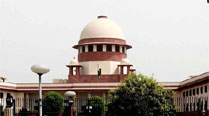Opinion War of blunt positions
Supreme Court itself has muddied constitutional interpretation beyond recognition.

 Let us for a moment grant that the Supreme Court’s final decisions in these cases have some merit.
Let us for a moment grant that the Supreme Court’s final decisions in these cases have some merit.
Just as the government is getting energised, another spectre is haunting India: chronic regulatory malfunction. The Supreme Court’s judgments cancelling the allocation of coal blocks and striking down the National Tax Tribunal Act have set the cat among the pigeons. There are interesting technical issues in both cases that deserve longer discussion. But in different ways, the net result of the judgments will be to dent the credibility of the Indian state. In a purely formal and legalistic sense, these rulings will be seen as the triumph of accountability, a Supreme Court holding a deviant executive to account. But the institutional picture they project is of a regulatory order beset by confusion, uncertainty and happenstance, rather than a consistent rule of law. Our regulatory state is now so tangled up in knots that if you pull at any one of the threads, even with the good intention of reform, it is not clear what might collapse.
Let us for a moment grant that the Supreme Court’s final decisions in these cases have some merit. But they raise serious fears about the state’s regulatory capacities, fears that will not be easy to mitigate. First, the chasm between the judiciary and the legislature’s understanding of what the Constitution requires is widening. Some of that may be due to the executive’s vested interests in corruption. But corruption is only a small part of the story. Over the last decade or so, the executive has lost a majority of important regulatory reform cases in areas as diverse as education and taxation. This suggests that different branches of government are working with different interpretations of what the general provisions of the Constitution require. The courts are from Mars and the legislature is from Venus. And the requisite dialogue to create a shared constitutional understanding is not happening. In the coal case, the silver lining might be that the government now has the political cover to repeal the Coal Mines (Nationalisation) Act and start afresh. But how many of you want to bet money that even a good-faith legislation will not be tripped up somewhere for being incompatible with some other law?
Second, the Supreme Court itself has muddied constitutional interpretation beyond recognition. Important principles like judicial independence, basic structure, separation of powers and public interest, on which the court has expanded its power, are often too abstract to know where their application will lie. In the tax tribunal case, the Supreme Court has contended that the tribunal had not just usurped the powers of the high court, but that the methods of appointment and so forth do not conform to the norms of independence that might be required for a court-like tribunal. Fair enough. But is it clear what standard a tribunal has to meet to pass this test? The National Green Tribunal, another consequential economic tribunal, was constituted practically under the orders of the Supreme Court, and under its supervision. Does it meet this test? You could say that since a Supreme Court judge is the chairman of the selection committee, it does. On the other hand, you could say that since government can vary the composition of the selection committee, it does not. In short, many of the high principles the court invokes are more like throws in a judicial roulette.
Third, even when holding the executive accountable, the court has dispensed with all known principles of natural justice. This column had contended that in the 2G case, the court had dispensed with all requirements of natural justice, including pre-empting the question of guilt without a full lower court hearing. What is jarring in the coal decision is not just that ordinary citizens will see that there is no statute of limitations in India. Its short-run economic consequences are also not an issue — the court cannot be instrumental about the rule of law. But here is a real issue. If the state makes a mistake, and 20 years later, a private party that was a beneficiary of that particular contract with the state has to suffer because of the state’s errors, what protection do I have? How am I, as a private citizen, supposed to know whether the state did its procedural due diligence? How do I know whether the committee met for three minutes or had a full discussion, whether all companies were properly vetted and so on? Again, corruption is the easy issue. Contracts where there is corruption need to be annulled. But like in the 2G case, the court has detected a massive lapse without fixing anyone’s responsibility.
The CBI kicks in only if it can prove real corruption. Who bears the costs of the state’s lapse? There is little protection for good-faith investors. Corruption has so clouded our thinking that these deeper underlying issues are being given short shrift. Just think of the range of areas where this is an issue. In land acquisition, if the state does not conduct a social impact assessment properly, or in the case of the environment, an environmental impact assessment, should the costs be borne by only the private party that accepted a contract in good faith? If corruption privatises the public exchequer, this kind of regulatory structure gives no private party protection against state recklessness. If the court had been serious, it should have sent a real message to the state. The only message it sent was that the state can easily pass on all the costs of its lapses to private citizens.
Fourth, there are doubts about whether the ways in which the courts interpret the Constitution are compatible with the rise of the modern regulatory state. In the tax case, for example, the court has plausibly said that only high courts can decide a substantial point of law. Fair enough. But it is not self-evident what a substantial point of law is. In a modern regulatory state, even policy can be reinterpreted as a substantial point of law. Let us face it: there is increasingly going to be a deep tension between the emerging complexities of the administrative state and the narrow conceptual lenses through which lawyers and judges view these matters. To be fair, this is a global phenomenon. Premature and excessive judicialisation of so many matters is making the creation of sensible policy difficult. It is generating a war of blunt positions.
At the very least, the government has its legal homework cut out for it. Bureaucrats can be energised. But our regulatory order has now been pulled from all sides. It is like an elastic stretched out of shape. Good luck fixing it.
The writer is president, Centre for Policy Research, Delhi, and a contributing editor for
‘The Indian Express’
express@expressindia.com




